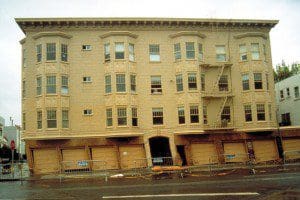NOT all seismic retrofit upgrades are the same. We’ve been doing soft-story retrofits long before they had that name. Here at JYASF, we’ve always been conscious of the importance of seismically robust structures. For the last 25 years we have worked closely with property owners and developers to increase the seismic safety of their buildings through voluntary retrofit measures. Often times owners ask us to recommend what they can do to keep their buildings, and more importantly the occupants, safe during an earthquake. Many of these buildings are the very types which have been identified by the City’s Mandatory Retrofit Program. Our extensive experience with such upgrades enable us to collaborate with you on cost effective solutions with considerations for enhancement the use of space. So what types of structural elements does a typical retrofit involve? Well, each building is unique and we will target a solution which works best for yours. But often they include a few basic elements – plywood shear walls, steel moment frames or steel braced frames – and more times than not, a combination of all of these. Plywood Shear Walls are standard wood stud framed walls covered with plywood. The plywood is heavily nailed the studs to produce a stiff wall for resisting earthquakes. The walls are attached to the floor above and anchored into the foundations below to prevent them from sliding and rocking.
Dollar-for-dollar, plywood shear walls are the most economical way to retrofit the soft story. Often they can be constructed by reinforcing existing walls. However, in order to be effective the need to be installed on walls of minimum lengths, and this may be a problem if that wall length is not there. If the space layout can accommodate it, adding a wall in a strategic location with a foundation below is relatively easy. If not, we need to look at other alternatives…. Steel Moment Frames are another very common type of structural element used in soft story retrofits. Moment frames consist of steel columns and beams connected so that they are relatively rigid, and like plywood shear walls are attached to the floor above and anchored into the foundation. They are significantly more expensive to construct than plywood shear walls but allow the greatest amount of flexibility within the floor plan. Often times they are installed around a garage door opening, or locations where adding a solid wall would be undesirable. Steel Braced Frames, while less common than steel moment frames, offer a lot of strength within a small footprint. They can be hidden in short sections of solid wall (much shorter than a plywood shear wall would require) and are often one-half to one-quarter the cost of a steel moment frame. Retrofit work to comply with the City of San Francisco mandatory soft story ordinance is an opportunity for not only seismically upgrading and increasing the safety of the structure, but also enhancing the flexibility and use of space.
This opportunity, with thoughtful planning, could transform the target floor (commonly the ground floor that is used as utility room, garage, retail or storage space) into a more desirable space. The benefits of the development of the space could easily outweigh the added cost of such undertaking. A list of such developments include:
- Conversion of the space to residential unit or added living space
- Expansion of the garage space to accommodate additional parking
- Partial excavation to create living, work, or storage space
- Removal of walls and columns to enhance the space layout for better use of the space
- Clean up those abandoned pipes, ducts, wiring and upgrade the mechanical and plumbing system in the building
These improvements can be planned when embarking on the design of the soft story retrofit, and implemented along with the construction. They will undoubtedly enhance quality of life and add value to the building. Soft story seismic improvements are looked upon favorably by the Lending Community. After all such improvements go a long way in protection of the asset that they have allocated their financial resources in lending. Major banks and other entities, including the current lender on the property (if there is a loan on the property) are eager to provide financing for the soft story projects in this low interest rate environment.

